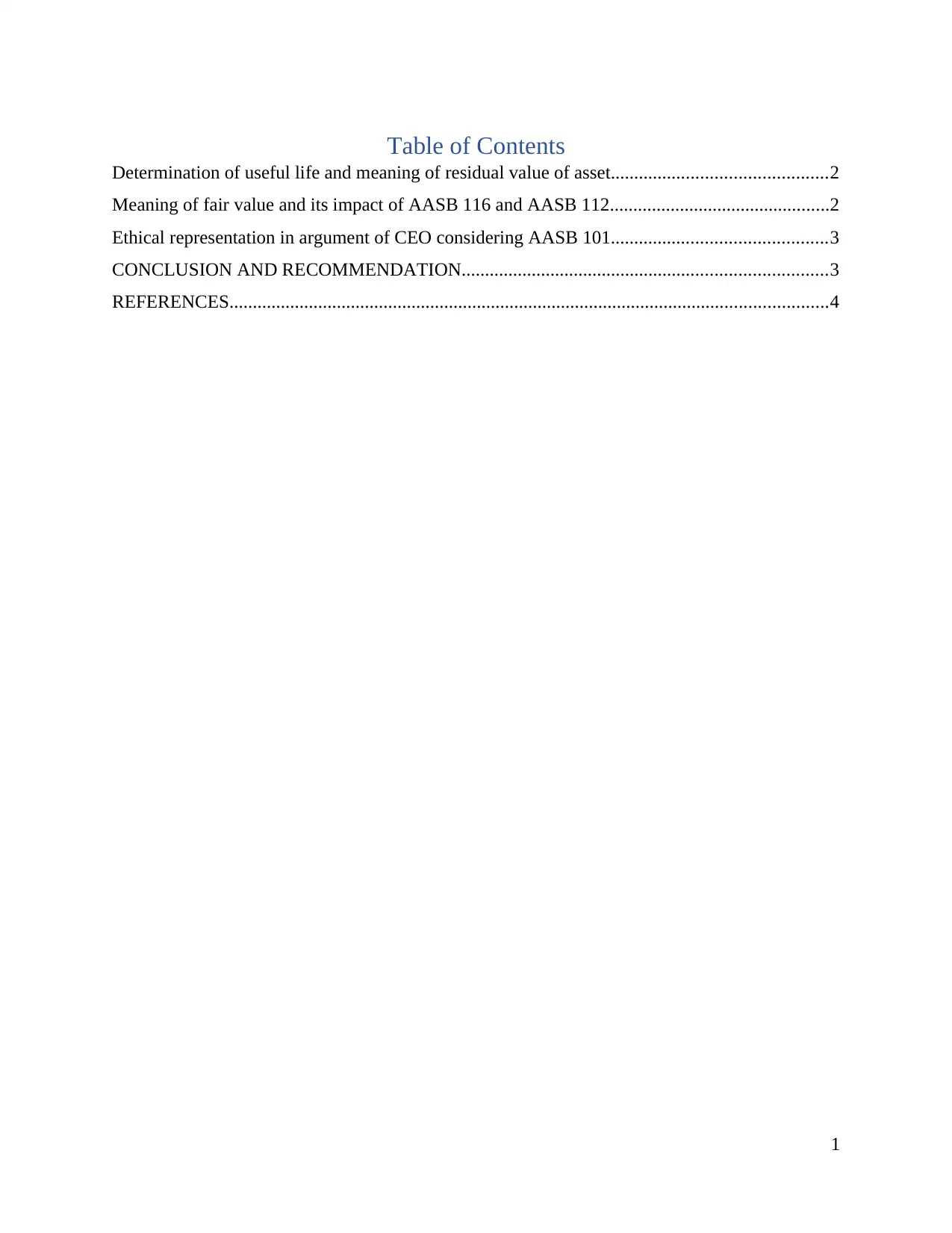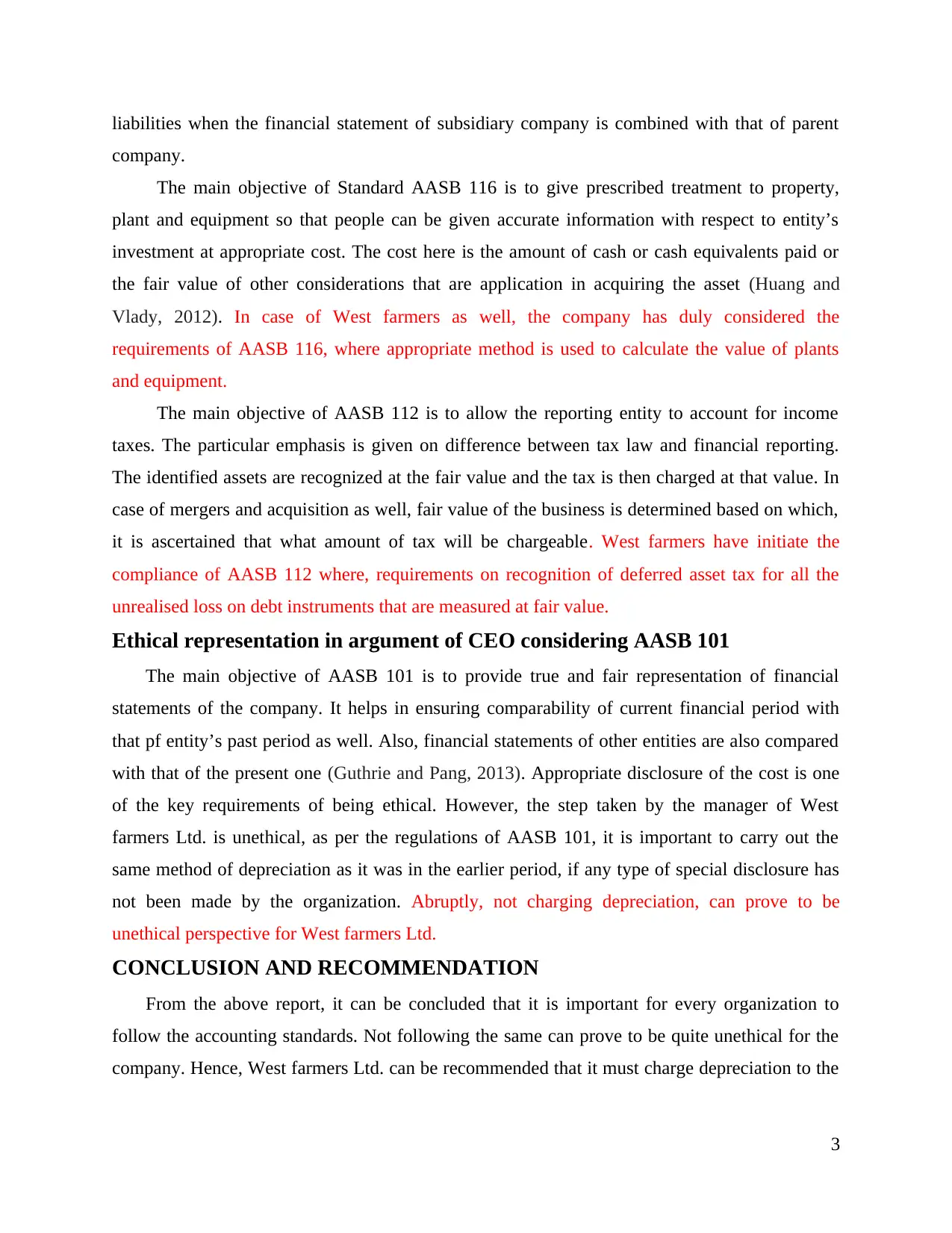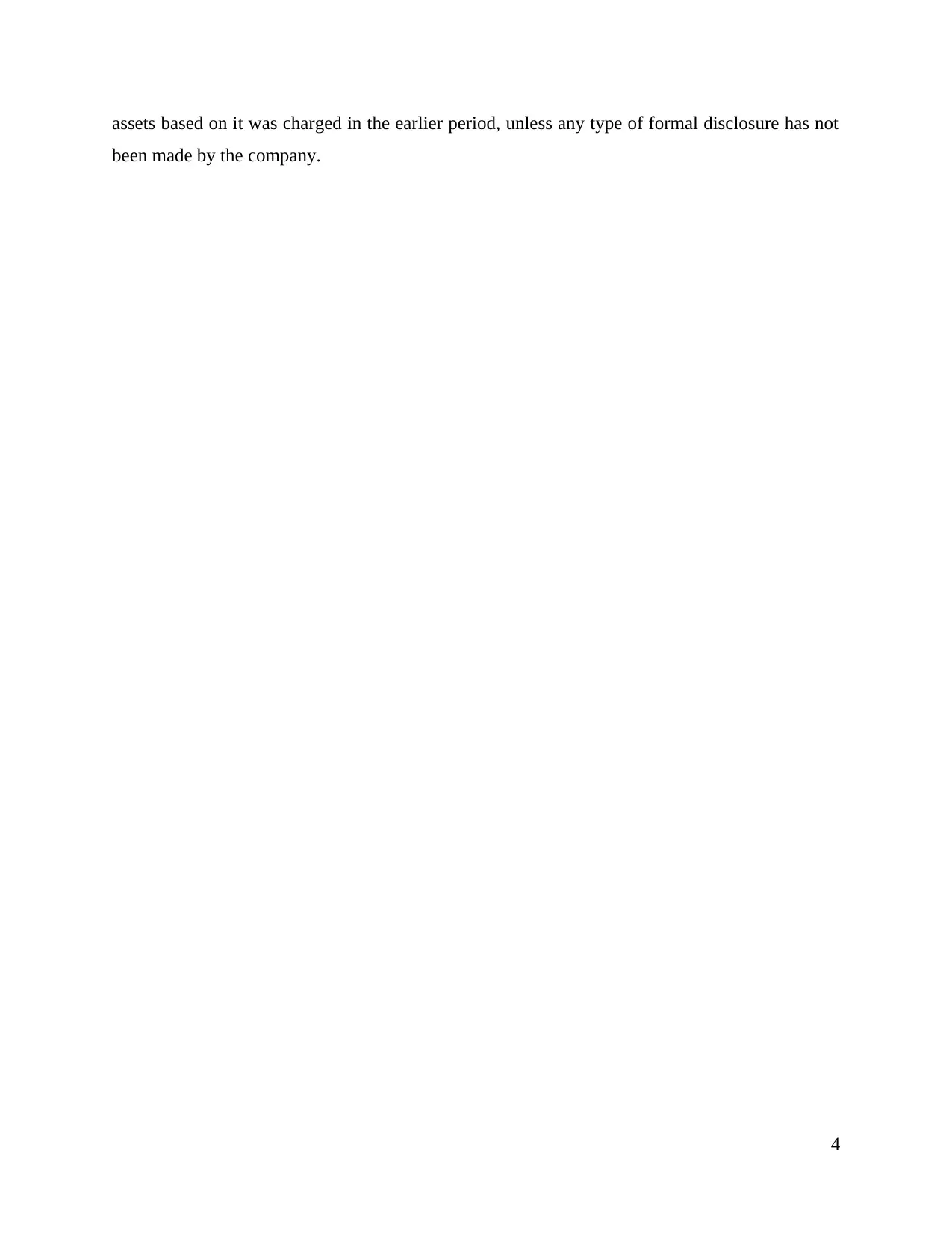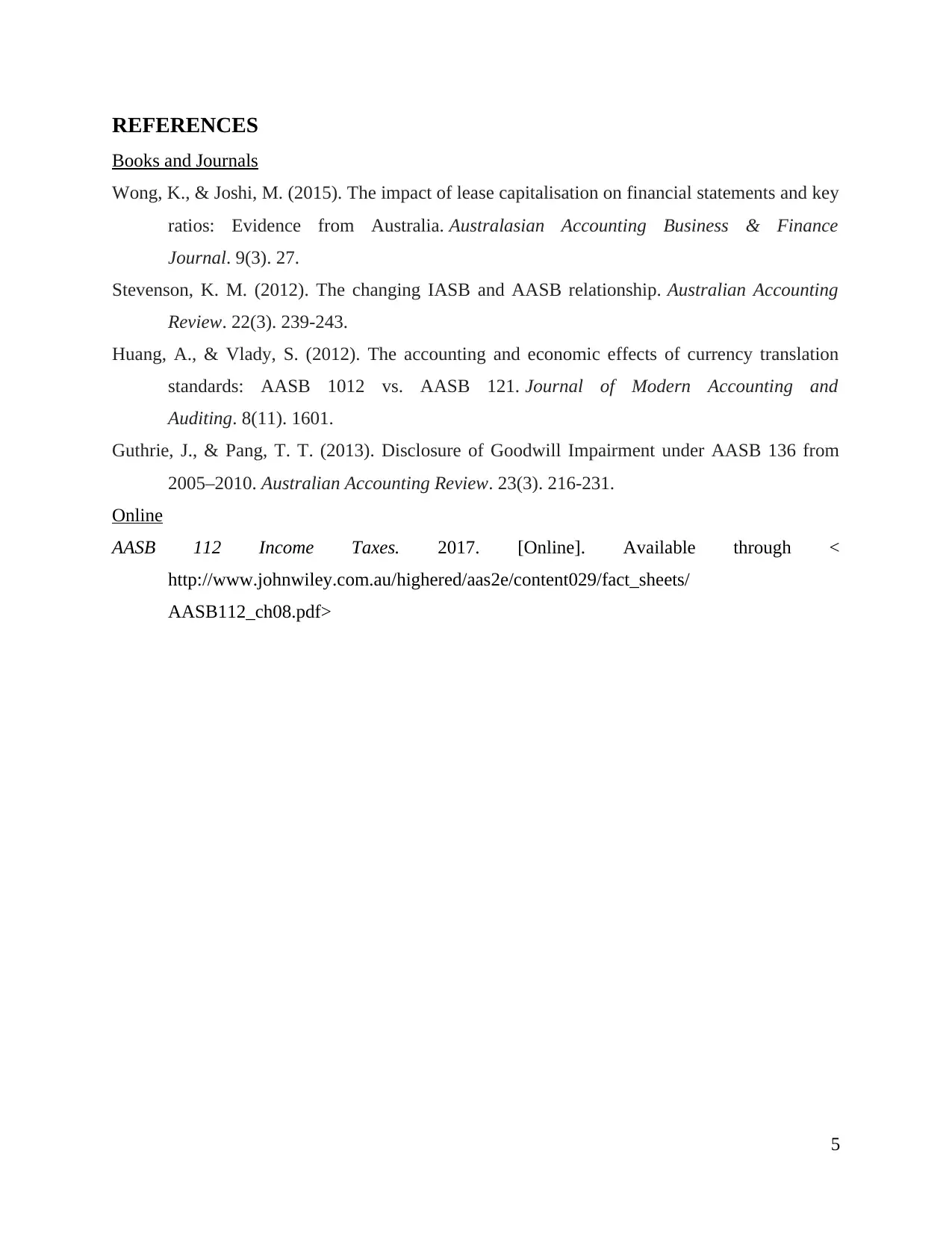Financial Accounting Report: AASB Standards and Ethical Practices
VerifiedAdded on 2021/01/02
|6
|1167
|275
Report
AI Summary
This financial accounting report delves into critical concepts such as the determination of an asset's useful life and the meaning of its residual value, providing a foundational understanding of asset valuation. It explores the definition of fair value and its implications under AASB 116 and AASB 112, highlighting the standards' impact on financial reporting. Furthermore, the report examines ethical representation in the context of a CEO's argument, considering the guidelines of AASB 101, and discusses the importance of adhering to accounting standards for accurate and transparent financial statements. The analysis includes real-world examples and concludes with recommendations for best practices in financial accounting, emphasizing the need for consistent depreciation methods and ethical considerations. This report is available on Desklib, a platform offering AI-based study tools.

Financial Accounting and
Reporting
Reporting
Paraphrase This Document
Need a fresh take? Get an instant paraphrase of this document with our AI Paraphraser

Table of Contents
Determination of useful life and meaning of residual value of asset..............................................2
Meaning of fair value and its impact of AASB 116 and AASB 112...............................................2
Ethical representation in argument of CEO considering AASB 101..............................................3
CONCLUSION AND RECOMMENDATION..............................................................................3
REFERENCES................................................................................................................................4
1
Determination of useful life and meaning of residual value of asset..............................................2
Meaning of fair value and its impact of AASB 116 and AASB 112...............................................2
Ethical representation in argument of CEO considering AASB 101..............................................3
CONCLUSION AND RECOMMENDATION..............................................................................3
REFERENCES................................................................................................................................4
1

Determination of useful life and meaning of residual value of asset
The useful life of an asset is the period of time which company tends to estimate to assess
the economic feasibility of the asset. In other words, it is the duration that a particular r asset will
be in service and is used to earn certain amount of revenue for the organization (AASB 112
Income Taxes, 2017). In order to estimate useful life, it is important for the organization to use
past experience with similar type of asset, industry practices, statistical methods, judgemental
estimates and other engineering estimates. However, there is certain typical range of useful life
estimates which are taken into consideration by organization, which are mentioned below:
Automotive equipment: 3 to 6 years
Furniture and Fixtures: 5 to 12 years
Machinery and equipment: 3 to 20 years (Wong and Joshi, M., 2015)
Buildings and improvements: 10 to 50 years
Evaluation of useful life is also subjected to overall judgement of management which can
also be revised during the life of fixed asset as well. Since, the figure is quite uncertain,
conservative accounting practices must be followed to ensure that right type of decision has been
taken by the organization.
Residual value ios also called as salvage value. It is the remaining value of a particular asset
after it has already been fully depreciated. It is calculated with the help of base prices that is
calculated after depreciation. It is considered to be the base price based on which that overall
calculation of depreciation is initiated. In case of West farmers, the useful life of building being
held by it, is 20 years to 40 years. However, in case of plant and equipment, it is 3 years to 40
years.
Meaning of fair value and its impact of AASB 116 and AASB 112
Fair value is considered to be rational and unbiased approach used to ascertain the potential
market price of a good, asset or a service. There are various factors that are taken into account
while assessing fair value. These factors are, acquisition or distribution cost, supply versus
demand, social productive capability of the asset, characteristics of risk involved to it, cost of and
return on capital and individually perceived utility (Stevenson, 2012). In other words, it can be
stated that, fair value is the sales price which has been agreed by buyer and seller both. Further,
on the same value, the security will be traded. It is also the representation of company’s asset and
2
The useful life of an asset is the period of time which company tends to estimate to assess
the economic feasibility of the asset. In other words, it is the duration that a particular r asset will
be in service and is used to earn certain amount of revenue for the organization (AASB 112
Income Taxes, 2017). In order to estimate useful life, it is important for the organization to use
past experience with similar type of asset, industry practices, statistical methods, judgemental
estimates and other engineering estimates. However, there is certain typical range of useful life
estimates which are taken into consideration by organization, which are mentioned below:
Automotive equipment: 3 to 6 years
Furniture and Fixtures: 5 to 12 years
Machinery and equipment: 3 to 20 years (Wong and Joshi, M., 2015)
Buildings and improvements: 10 to 50 years
Evaluation of useful life is also subjected to overall judgement of management which can
also be revised during the life of fixed asset as well. Since, the figure is quite uncertain,
conservative accounting practices must be followed to ensure that right type of decision has been
taken by the organization.
Residual value ios also called as salvage value. It is the remaining value of a particular asset
after it has already been fully depreciated. It is calculated with the help of base prices that is
calculated after depreciation. It is considered to be the base price based on which that overall
calculation of depreciation is initiated. In case of West farmers, the useful life of building being
held by it, is 20 years to 40 years. However, in case of plant and equipment, it is 3 years to 40
years.
Meaning of fair value and its impact of AASB 116 and AASB 112
Fair value is considered to be rational and unbiased approach used to ascertain the potential
market price of a good, asset or a service. There are various factors that are taken into account
while assessing fair value. These factors are, acquisition or distribution cost, supply versus
demand, social productive capability of the asset, characteristics of risk involved to it, cost of and
return on capital and individually perceived utility (Stevenson, 2012). In other words, it can be
stated that, fair value is the sales price which has been agreed by buyer and seller both. Further,
on the same value, the security will be traded. It is also the representation of company’s asset and
2
⊘ This is a preview!⊘
Do you want full access?
Subscribe today to unlock all pages.

Trusted by 1+ million students worldwide

liabilities when the financial statement of subsidiary company is combined with that of parent
company.
The main objective of Standard AASB 116 is to give prescribed treatment to property,
plant and equipment so that people can be given accurate information with respect to entity’s
investment at appropriate cost. The cost here is the amount of cash or cash equivalents paid or
the fair value of other considerations that are application in acquiring the asset (Huang and
Vlady, 2012). In case of West farmers as well, the company has duly considered the
requirements of AASB 116, where appropriate method is used to calculate the value of plants
and equipment.
The main objective of AASB 112 is to allow the reporting entity to account for income
taxes. The particular emphasis is given on difference between tax law and financial reporting.
The identified assets are recognized at the fair value and the tax is then charged at that value. In
case of mergers and acquisition as well, fair value of the business is determined based on which,
it is ascertained that what amount of tax will be chargeable. West farmers have initiate the
compliance of AASB 112 where, requirements on recognition of deferred asset tax for all the
unrealised loss on debt instruments that are measured at fair value.
Ethical representation in argument of CEO considering AASB 101
The main objective of AASB 101 is to provide true and fair representation of financial
statements of the company. It helps in ensuring comparability of current financial period with
that pf entity’s past period as well. Also, financial statements of other entities are also compared
with that of the present one (Guthrie and Pang, 2013). Appropriate disclosure of the cost is one
of the key requirements of being ethical. However, the step taken by the manager of West
farmers Ltd. is unethical, as per the regulations of AASB 101, it is important to carry out the
same method of depreciation as it was in the earlier period, if any type of special disclosure has
not been made by the organization. Abruptly, not charging depreciation, can prove to be
unethical perspective for West farmers Ltd.
CONCLUSION AND RECOMMENDATION
From the above report, it can be concluded that it is important for every organization to
follow the accounting standards. Not following the same can prove to be quite unethical for the
company. Hence, West farmers Ltd. can be recommended that it must charge depreciation to the
3
company.
The main objective of Standard AASB 116 is to give prescribed treatment to property,
plant and equipment so that people can be given accurate information with respect to entity’s
investment at appropriate cost. The cost here is the amount of cash or cash equivalents paid or
the fair value of other considerations that are application in acquiring the asset (Huang and
Vlady, 2012). In case of West farmers as well, the company has duly considered the
requirements of AASB 116, where appropriate method is used to calculate the value of plants
and equipment.
The main objective of AASB 112 is to allow the reporting entity to account for income
taxes. The particular emphasis is given on difference between tax law and financial reporting.
The identified assets are recognized at the fair value and the tax is then charged at that value. In
case of mergers and acquisition as well, fair value of the business is determined based on which,
it is ascertained that what amount of tax will be chargeable. West farmers have initiate the
compliance of AASB 112 where, requirements on recognition of deferred asset tax for all the
unrealised loss on debt instruments that are measured at fair value.
Ethical representation in argument of CEO considering AASB 101
The main objective of AASB 101 is to provide true and fair representation of financial
statements of the company. It helps in ensuring comparability of current financial period with
that pf entity’s past period as well. Also, financial statements of other entities are also compared
with that of the present one (Guthrie and Pang, 2013). Appropriate disclosure of the cost is one
of the key requirements of being ethical. However, the step taken by the manager of West
farmers Ltd. is unethical, as per the regulations of AASB 101, it is important to carry out the
same method of depreciation as it was in the earlier period, if any type of special disclosure has
not been made by the organization. Abruptly, not charging depreciation, can prove to be
unethical perspective for West farmers Ltd.
CONCLUSION AND RECOMMENDATION
From the above report, it can be concluded that it is important for every organization to
follow the accounting standards. Not following the same can prove to be quite unethical for the
company. Hence, West farmers Ltd. can be recommended that it must charge depreciation to the
3
Paraphrase This Document
Need a fresh take? Get an instant paraphrase of this document with our AI Paraphraser

assets based on it was charged in the earlier period, unless any type of formal disclosure has not
been made by the company.
4
been made by the company.
4

REFERENCES
Books and Journals
Wong, K., & Joshi, M. (2015). The impact of lease capitalisation on financial statements and key
ratios: Evidence from Australia. Australasian Accounting Business & Finance
Journal. 9(3). 27.
Stevenson, K. M. (2012). The changing IASB and AASB relationship. Australian Accounting
Review. 22(3). 239-243.
Huang, A., & Vlady, S. (2012). The accounting and economic effects of currency translation
standards: AASB 1012 vs. AASB 121. Journal of Modern Accounting and
Auditing. 8(11). 1601.
Guthrie, J., & Pang, T. T. (2013). Disclosure of Goodwill Impairment under AASB 136 from
2005–2010. Australian Accounting Review. 23(3). 216-231.
Online
AASB 112 Income Taxes. 2017. [Online]. Available through <
http://www.johnwiley.com.au/highered/aas2e/content029/fact_sheets/
AASB112_ch08.pdf>
5
Books and Journals
Wong, K., & Joshi, M. (2015). The impact of lease capitalisation on financial statements and key
ratios: Evidence from Australia. Australasian Accounting Business & Finance
Journal. 9(3). 27.
Stevenson, K. M. (2012). The changing IASB and AASB relationship. Australian Accounting
Review. 22(3). 239-243.
Huang, A., & Vlady, S. (2012). The accounting and economic effects of currency translation
standards: AASB 1012 vs. AASB 121. Journal of Modern Accounting and
Auditing. 8(11). 1601.
Guthrie, J., & Pang, T. T. (2013). Disclosure of Goodwill Impairment under AASB 136 from
2005–2010. Australian Accounting Review. 23(3). 216-231.
Online
AASB 112 Income Taxes. 2017. [Online]. Available through <
http://www.johnwiley.com.au/highered/aas2e/content029/fact_sheets/
AASB112_ch08.pdf>
5
⊘ This is a preview!⊘
Do you want full access?
Subscribe today to unlock all pages.

Trusted by 1+ million students worldwide
1 out of 6
Related Documents
Your All-in-One AI-Powered Toolkit for Academic Success.
+13062052269
info@desklib.com
Available 24*7 on WhatsApp / Email
![[object Object]](/_next/static/media/star-bottom.7253800d.svg)
Unlock your academic potential
Copyright © 2020–2025 A2Z Services. All Rights Reserved. Developed and managed by ZUCOL.





